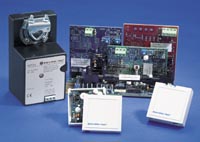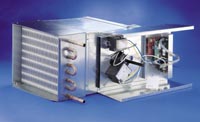Fierce competition motivates commercial office building owners and real estate managers to provide comfortable office space while minimizing air conditioning power consumption and initial construction costs. Direct Digital Controls (DDC) are frequently mounted on each variable air volume (VAV) terminal, permitting communication between the automation system central monitor and each VAV unit. Analog Electronic Controls (AEC) for VAV terminals provide a viable lower cost alternative to DDC control.
Both sophisticated, solid state Analog Electronic and DDC VAV controllers provide superior zone comfort by minimizing room temperature deviation from setpoint. Both systems permit night setback and morning warm-up operation. Both allow the user to factory and/or field set minimum and maximum airflow settings. Both provide pressure independent control. Neither requires annual calibration as do the proportional pneumatic controllers.
 ENVIRO-TEC Analog VAV controllers offer options such as night set back, morning warm-up, summer/winter changeover, dual minimum setpoint, one, two, and three step or modulating heat. Constant volume and constant pressure controllers, as well as many special sequences, are available from ENVIRO-TEC.
What is the First Cost Premium for DDC Communications Between VAV Terminals and the Building Automation Front End?
The VAV controller type significantly impacts the building cost. The VAV controller contributes between $.21/square foot and $1.44/square foot to the initial cost of a building. The first cost of a DDC VAV controller is more than the cost of the VAV single zone terminal. The analog VAV control is less than half the cost of the DDC control.
| COMPARISON OF DDC AND ANALOG CONTROL COSTS |
| |
Analog Controls |
DDC Controls |
| Controller & T-Stat |
$152 |
$257 |
| Wiring and Setup |
$40 |
$175 |
| Total |
$192 |
$432 |
| COST OF VAV CONTROLS PER SQUARE FOOT |
| |
Analog Controls |
DDC Controls |
| Average Zone Area |
300 sq. ft. |
900 sq. ft. |
300 sq. ft. |
900 sq. ft. |
| Cost per Sq. Foot |
$.64 / sq. ft. |
$.21 / sq. ft. |
$1.44 / sq. ft. |
$.48 / sq. ft. |
In view of the cost difference between Analog Electronic controllers and DDC controllers (see above) when should the owner and HVAC system designer use DDC VAV control?
DDC control systems provide two way communications between the VAV terminal controllers and the automation system front end. From their office, a building manager can view zone temperatures, VAV unit operating status, zone airflow rates, and zone heating and cooling setpoints. They can reset zone temperature setpoints and minimum and maximum airflow limits. Zone controllers can send an alarm to the central monitor when abnormal conditions arise. These are powerful tools which meet requirements for some owners and tenants.
However, for the typical office space, the owner may find it more cost effective to limit DDC building automation to large chillers, boilers, major air handling units, fire and life safety systems, and other critical applications.
For non-critical zones, VAV zone terminals may only require Analog Electronic Controllers with system interlock controls. The VAV Analog Electronic Controls have the same dependability and accuracy as DDC Controls. They also allow the minimum and maximum CFM setpoints to be adjusted from the local space thermostat for ease of balancing the airside of the HVAC system. In addition, the Series 7000 Analog Electronic Controls incorporate a plug-in modular design for ease of adding features such as
morning warm-up, night set back and additional stages of heat, without replacing the original master controller.
Communications wiring for DDC controllers may become prohibitive when great distances or remote buildings are involved. In those cases, stand-alone Analog Electronic Controls may be the only practical choice.
Commissioning DDC VAV systems requires factory trained staff familiar with DDC hardware and software, increasing the installed costs of DDC systems. The operating cost also increases because the owner has to employ highly trained technicians to maintain the system or pay for expensive yearly maintenance contracts from the local controls manufacture representative.
 ENVIRO-TEC electronic analog and DDC controllers are quality tested for 24 hours prior to final assembly within a NEMA 1 enclosure with transformer and actuator. All terminal units and control assemblies are ETL listed with the electronic controllers factory mounted. ENVIRO-TEC® onboard transducers and FlowStar™ airflow sensors are capable of accurately controlling at lower airflow rates than typically available in the industry.
When renovating buildings that have pneumatic controls or expanding campuses that have long used pneumatic VAV controls, the owner should consider replacing the pneumatic controls with Analog Electronic VAV Controls. Analog Electronic VAV Controls enjoy several advantages over their pneumatic counterparts with approximately the same initial installed first cost.
- Analog controls eliminate the first cost of air compressors, filter / driers and pneumatic piping.
- Analog controls, unlike pneumatic, do not require annual calibration of thermostat and controllers.
- Air compressor, pneumatic piping and filter / drier maintenance and operating costs are eliminated.
- Analog controllers maintain space temperatures within ± 1°F which provides better comfort and greater energy efficiency than pneumatic controllers.
Many VAV system renovations are accomplished without replacing the sheet metal VAV terminals. Control system problems, such as malfunctioning VAV controllers and oil and water in pneumatic tubing, often have rendered a VAV system inoperable. Failure to annually calibrate pneumatic controls can also render the VAV system inoperable. In these instances, the system can be repaired by changing only the controls. Pressure dependent systems can be upgraded to a pressure independent systems by adding duct airflow sensor kits.
Savings to the owner can be substantial. VAV terminals and ductwork are reused. Disturbance of the ceiling is minimal. The controls retrofit is done in a fraction of the time that a complete renovation might take.
Conclusion
Stand-alone, Analog Electronic VAV Controllers offer the same reliability and low maintenance as DDC controls at a much lower operating and first cost. Additionally, they require only a standard volt/ohm multi-meter for setup and calibration, where DDC controls require a PC computer with expensive software and in many cases, costly product training. Perhaps the only advantage of DDC over analog is the communication with the PC workstation front end. As building owners and designers develop new projects and renovate existing properties, careful economic analysis will be required when selecting between Analog Electronic and communicating DDC control systems.
Top of Page |